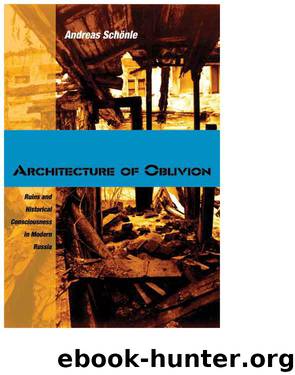Architecture of Oblivion: Ruins and Historical Consciousness in Modern Russia by Schönle Andreas

Author:Schönle, Andreas [Schönle, Andreas]
Format: epub
Publisher: Northern Illinois University Press
Published: 2011-06-14T16:00:00+00:00
In two lithographs Ostroumova gives us a vivid picture of the dying life of the river. She has immortalized the rotting carcasses of vessels, whose blackened bones have stuck out of the water for all these years, luring the ant-like people, who emerged in swarms, to gnaw at them and to carry the morsels they scavenged back to their cold burrows.
His mixed metaphors notwithstanding, in this passage Benois captured the uniquely complex aesthetic sensibility of the times, in which the deserted contemporary landscape evoked the youthful beauty of the city—when it was being erected as the ambitious vanguard of Russia’s nascent Westernized self—while at the same time conjuring up the poetry of decline and death. Was this return to the past a token of new beginnings? Or was this look backward a sign of ineluctable decline? Historical parallels might seem cruelly ironic, and it is surely symptomatic that Benois writes condescendingly of the survival strategies of Petersburg residents, thereby revealing a principled commitment to an aesthetic vision, which gave short thrift to existential misery. For Benois and Ostroumova-Lebedeva, the revolution had fulfilled one of their cherished ideals, the creation of an austere, spare, monumental landscape. 26
All three artists considered so far responded to the ruin of Petrograd by “creating an aesthetic filter” between themselves and the traumatic reality they faced, an attitude Polina Barskova explored in her article on representations of the ruins of Petrograd. 27 If Dobuzhinsky museified the whole city, collapsing its different temporal layers into a playful space of strident incongruities, Shillingovskii articulated its enduring classical beauty, which the presence of ruins only reinforced, while Ostroumova-Lebedeva undertook a bit of restorative work, presenting a depopulated, yet colorful and undamaged city of yore. All three artists, in their own individual ways, distanced themselves from the disturbing spectacle of ruination, and instead created an aesthetic rationale that located beauty in uncontrollable historical changes. Their larger point, as it were, was that reality, or time, was itself an artist, and that in post-revolutionary Petrograd, it had reasserted itself, defying human attempts to take charge of the future. Through their art and with the assistance of their critical mouthpieces, they lauded the poetry of unintended, fortuitous developments. In this respect, regardless of their views on economic progress, their attitude was fundamentally antimodern. And although they did not idealize the “profound peace” that Simmel ascribes to the ruin, they shared his sense that ruination provides an opportunity for reconciliation between conflicting historical vectors.
Yet not all responses to the ruins of 1918–1921 were cast in a retrospectivist mold. Viktor Shklovskii, for one, took a characteristically tongue-in-cheek view of the emerging ruination: “It was a feast of all-incineration. Wooden houses were dismantled and burned. Big buildings devoured small ones. Deep gaps emerged in the lines of the streets. . . . People carried out the demolition weakly and ineptly, forgetting to level chimneys, breaking glass, destroying one wall, instead of undoing a house one link at a time, like a chain. Artificial ruins appeared. The city was slowly transforming itself into an engraving by Piranesi.
Download
This site does not store any files on its server. We only index and link to content provided by other sites. Please contact the content providers to delete copyright contents if any and email us, we'll remove relevant links or contents immediately.
| African | Asian |
| Australian & Oceanian | Canadian |
| Caribbean & Latin American | European |
| Jewish | Middle Eastern |
| Russian | United States |
4 3 2 1: A Novel by Paul Auster(12290)
The handmaid's tale by Margaret Atwood(7685)
Giovanni's Room by James Baldwin(7199)
Asking the Right Questions: A Guide to Critical Thinking by M. Neil Browne & Stuart M. Keeley(5654)
Big Magic: Creative Living Beyond Fear by Elizabeth Gilbert(5617)
Ego Is the Enemy by Ryan Holiday(5297)
The Body: A Guide for Occupants by Bill Bryson(4978)
On Writing A Memoir of the Craft by Stephen King(4866)
Ken Follett - World without end by Ken Follett(4647)
Adulting by Kelly Williams Brown(4489)
Bluets by Maggie Nelson(4479)
Eat That Frog! by Brian Tracy(4440)
Guilty Pleasures by Laurell K Hamilton(4363)
The Poetry of Pablo Neruda by Pablo Neruda(4041)
Alive: The Story of the Andes Survivors by Piers Paul Read(3970)
White Noise - A Novel by Don DeLillo(3956)
Fingerprints of the Gods by Graham Hancock(3943)
The Book of Joy by Dalai Lama(3904)
The Bookshop by Penelope Fitzgerald(3781)
